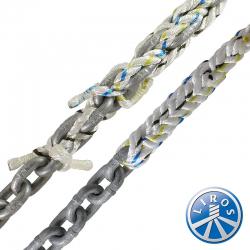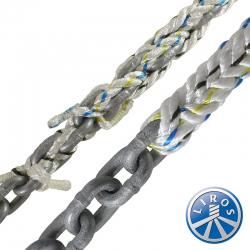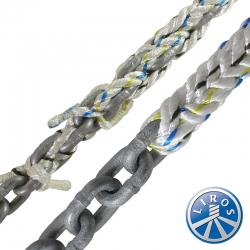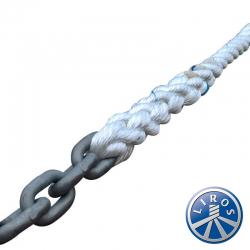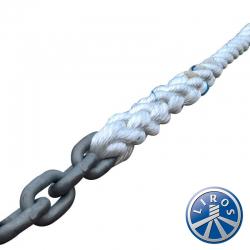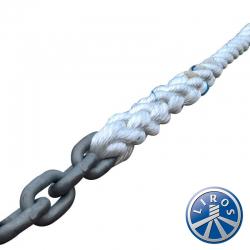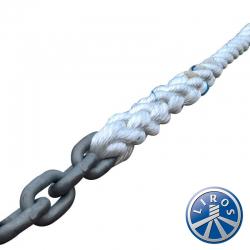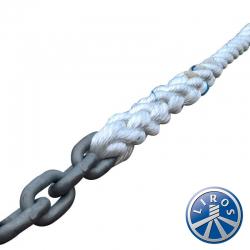Anchoring a sailing or motor yacht generally refers to the act of securing a boat’s position by attachment to the sea bed as opposed to mooring to any land-based strongpoint. Anchoring has long been considered not only an art but also a very important skill set by those who go to sea.
Modern high-holding anchors with automatic self-setting designs mean that anchoring in relatively benign conditions has become less problematic, but if you are caught out away from the sanctuary of your home berth by swiftly deteriorating weather conditions, the traditional virtues of selecting the optimum anchorage and securing your yacht with well-chosen ground tackle will go a long way to a good night’s sleep.
Anchoring System Assessment
An anchoring system includes the anchor, the anchor chain and warp, the connections between the component parts, the means of retrieval (windlass or "handraulic") and a snubbing arrangement where required.
Anchor Retrieval - assessing your windlass and other options
If you have one, these are the main assessment criteria – is it in good working order, does the chain fit on the gypsy correctly (the chain will jump during retrieval if it doesn’t) does it have enough pulling power for your intended anchor and rode, do you need to upgrade the remote operational facility, is there a facility for relieving the load from the windlass while at anchor?
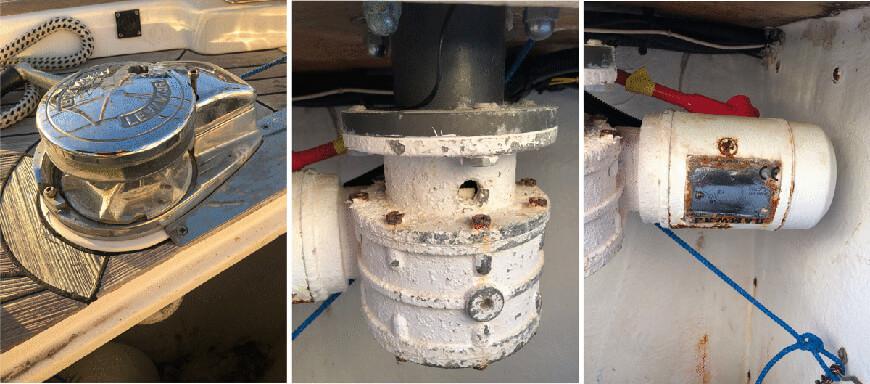
If you don’t have a windlass and don’t intend to get one, you will need to restrict the length of chain and extend the length of rope so that you can physically recover the anchor in periods of strong winds and big waves.
If you have decided to upgrade and get a windlass, consider the electrical installation implications and have a good look at other yachts with similar foredeck and chain locker layouts to get an idea of what makes and models may fit.
Purchasing a suitable windlass for your yacht is not so daunting as it may seem if you consult the Jimmy Green selection guide:
Windlass Selection
Anchor Selection
Does the existing anchor fit the stemhead properly, is it a good holding design, do you need it to be self-setting, even through a 180-degree wind shift or when the tide turns, is it heavy enough for your yacht, particularly in relation to your intended cruising? e.g. Ocean cruising will almost certainly mean long periods at anchor (live-aboard) whereas venturing out from your mooring for a day sail up and down an estuary may only result in dropping the hook for lunch or very occasionally overnight in a quiet creek.
Ground Tackle / Anchor Rode Options
Do I need Anchor Chain, Anchor Rope or a combination of Both?
For those blessed with an adequate windlass, all-chain is the popular choice, limited only by your budget, the size of the chain locker and the disadvantage of too much weight in the bow when under way. 50 metres used to be the norm, but 80-120 metres is much more prevalent in this day and age.
Where weight is a limiting factor, a balanced chain/warp combination is a very good solution e.g. 50 metres of chain spliced to 50 metres of rope. The balance can be adjusted proportionally but shouldn’t feature less than 30 metres of chain. The rope component should be as strong as the chain and as stretchy as possible to absorb the shock loads endured in big seas. The maximum diameter of the rope is generally restricted by the rope to chain splice.
For anchor retrieval with no power or mechanical advantage, a disproportionate warp/chain combination may be advisable with regard to retrieving the anchor, chain and warp by hand - Consider a long length of stretchy warp with a relatively short piece of chain to ground the anchor and negate the abrasive effects of the seabed e.g. anything from 50 up to 100 metres spliced to 5 or 10 metres of chain. Consider increasing the chain length and reducing the rope length if you or your crew are physically able to manage the extra weight.
The overall length of your rode, whether all-chain or a combination should reflect the depth and type of anchorages you will encounter, and the degree of risk associated with your anchoring intentions i.e. your reliance on ground tackle as a primary yacht safety factor.
An anchor rode comprising all-chain with no additional rope will require a snubbing strop or bridle.
This will help prevent the anchor chain from coming up short with a jolt which may have worrying results:
- Jerking the anchor from the set position in the seabed.
- Delivering a damaging shock load to the chain and/or the deck strongpoint fitting to which the chain is attached if the anchor doesn’t budge.
A combination Chain/Rope Anchor Rode may prove to be the optimum arrangement
The scope of the chain should still be more than adequate for anticipated anchorage depths and weather conditions.
The extra length of the rope extension will not only increase the scope, but also provide valuable shock absorbing capability if conditions seriously worsen.
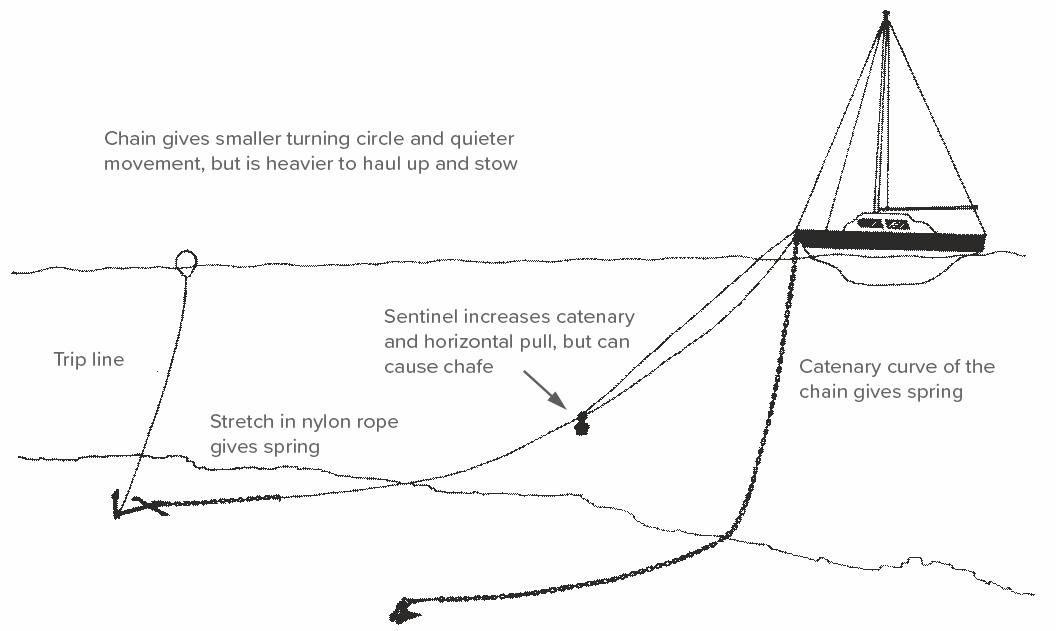
Anchor Rode Connections and Anchor Connectors
It is crucial to ensure that all the component parts are comparable in quality and of similar break load when connecting the anchoring system together because it will only be as strong as the weakest link.
Use manufacturer load-rated components with sound provenance wherever possible to ensure that the integrity of the whole body is not compromised by one weak link.
Anchor connectors and swivels have developed over recent years providing enhanced break load security and flip retrieval capability (turning the anchor so that it stows immediately and correctly on the stemhead) The more expensive options also offer a one-piece solution with lateral loading articulation and/or security.
Jimmy Green Marine will always recommend a continuous length of proof tested, minimum Grade 40, Hallmarked or otherwise provenance-assured calibrated anchor chain. We do offer connecting products, some rated, some unrated, some will that pass around a gypsy and some that don't. However, they all involve varying degrees of compromise to the overall strength and reliability of an anchoring system. We are happy to provide all the necessary information about the joining links so that our customers can weigh the risk against the marked increase in cost involved in replacing an entire anchor chain.
Rope to chain splicing is recommended for strength retention, smooth handling and successful operation around a windlass gypsy. Splicing a hard eye in the end of the anchor rope and shackling it to the chain will mean that the warp is more portable, stowable and versatile. The eye splice is completed after the rope is fitted around a teardrop shaped thimble which rules out using it on a windlass. Do not underestimate the importance of a correctly completed splice in terms of strength retention. Simply tying a knot has a serious detrimental effect on the break load capacity of any rope but the technique, quality and finish of the splicing is crucial to the performance of the rope. The Jimmy Green Splicing and Rigging Service offers peace of mind.
Anchor Snubbing
An anchor rode must be capable of absorbing the shock loads created when a yacht is brought up short in windy, wavy conditions.
All chain and combination rodes (when only the chain is deployed) will require a stretchy snubbing strop or bridle to relieve the snatch load. This will go a long way to preventing the anchor from being jerked out of the seabed and causing it to drag. It will also make the motion very much more comfortable for the crew aboard.
For all chain rodes, consider splicing a suitable length of anchor rope to the chain at the locker end to create a built-in snubbing line for when conditions worsen to the point that all the chain is deployed.
More information on Anchor Snubbing
Selection Process for determining the right size for your Main Anchor Chain and Rope
- What Size Anchor Chain do I need ?
- What Size Anchor Rope is compatible with my chain ?
- How much Anchor Chain do I need ?
- How much Anchor Rope do I need ?
Select your Anchor Chain and compatible Anchor Rope size
- Find the column in the table below that best represents your Boat Length Overall.
- Compare your displacement with the tonnage listed.
- If the displacement is greater than displayed in your column in the table, or your yacht is a multihull, consider moving across to the next column to increase the diameter.
- Consider the worst-case scenario for your anticipated Anchoring - this will dictate whether you go for the minimum required or the 'belt and braces' approach
- Select your Anchor Chain size first. The guide indicates the compatible rope diameter.
Benchmark Guide for determining the size of your Main Anchor Rode
| Yacht Length Overall |
< 6 metres |
6 - 8 metres |
8 - 10 metres |
10 - 12 metres |
12 - 14 metres |
14 - 16 metres |
16 - 18 metres |
18 - 20 metres |
| Approximate length in feet |
< 20 feet |
20 - 26 feet |
26 - 33 feet |
33 - 40 feet |
40 - 46 feet |
46 - 53 feet |
53 - 60 feet |
60 - 66 feet |
| Displacement in Tonnes |
1 tonne |
2.5 tonnes |
5 tonnes |
9 tonnes |
13 tonnes |
16 tonnes |
20 tonnes |
25 tonnes |
| Chain Size |
6mm |
7/8mm |
8mmm |
8/10mm |
10mm |
10mm |
10/12mm |
12mm |
| Warp Diameter |
10mm |
12mm |
14mmm |
14/16mm |
16mm |
18mm |
20mm |
24mm |
N.B. This table is only a guide with columns based on:
- Top Quality LIROS Rope
- LIROS recommendation
- Jimmy Green experience and customer feedback
- Top Quality Grade 40 Anchor Chain
Anchor Chain Size Rule of Thumb
There is an old rule of thumb that dates back many years which states a requirement of 1/8" chain diameter for every 9 or 10 feet of boat length - with approximate metric conversions: e.g. 1/4" now available as 6mm DIN766 chain would be up to 20 or 23 feet Yacht LOA, 7mm DIN766 chain would be up to 23 or 27 feet, 5/16" now available as 8mm DIN766 would be up to 27 or 31 feet Yacht LOA, 3/8" now available as 10mm DIN766 and 10mm ISO would be up to 34 or 39 feet Yacht LOA.
5/16" US Specification (8.7mm) chain is also available from Jimmy Green Marine and the rule of thumb would be up to 29 or 34 feet LOA
This rule of thumb isn't far removed from the Jimmy Green Anchor Chain Size Guide but it is probably based on Grade 30 chain because Grade 40 is a relatively recent advance for yachting anchor chain. Although modern yachts are generally designed and built with lighter state-of-the-art materials, they are quite often kitted out with a lot more equipment to add the weight back on and the current trend is towards bigger anchors with much higher holding power which will inevitably lead to higher loads on the anchor rode.
Grade 40 Calibrated Anchor Chain is 25%+ stronger than Grade 30 Anchor Chain providing extra assurance when conditions worsen and your yacht is caught on a lee shore.
An Anchor Rode comprises all parts of your anchoring system - anchor chain, anchor rope and all the connections.
Decision-Making Factors for sizing your Anchor Chain and Anchor Warp:
- Displacement to Length ratio i.e. is your yacht relatively light or heavy for her length?
- Mono or Multihull - catamarans may be subject to increased anchoring stresses and strains
- Anticipated anchoring conditions e.g. depth, seabed holding characteristics, the length of fetch and degree of exposure to prevailing winds.
- Your overall assessment of the risks involved (worst case scenario).
- Weight and design of your bower (main anchor) and also the specification of your secondary anchoring system.
An Anchoring System includes every part of the anchor rode from the anchor to the bitter end: anchor, chain, warp and all the individual means of joining it all together e.g. connectors, swivels, shackles, splicing.
All the individual parts need to be comparable in strength. The Anchor System is only as strong as the weakest link. The increased holding power of modern anchors means that all the joining elements are subjected to higher loads than ever before.
Rope diameters compatible with Calibrated Anchor Chain: Compatibility rests on two main factors:
- Break Load Comparison
- Physical limitations of the Rope to Chain Splice i.e. the largest rope that will splice into the chain links, sit comfortably and articulate satisfactorily
6mm Grade 40 Chain c 2300kg MBL Compatible = 10mm Anchorplait Nylon, LIROS MBL 2400kg
7mm Grade 40 Chain c 3100kg MBL ~ Downsize = 10mm Anchorplait Nylon, LIROS MBL 2400kg or Compatible = 12mm Anchorplait Nylon, LIROS MBL 3300kg
8mm Grade 40 Chain c 4000-4400kg MBL ~ Compatible = 14mm Anchorplait Nylon, LIROS MBL 4400kg or Largest Possible for satisfactory splicing = 16mm Anchorplait Nylon, LIROS MBL 5600kg
10mm Grade 40 Chain c 6400-7200kg MBL ~ Slight Downsize = 16mm Anchorplait Nylon LIROS MBL 5600kg or Compatible = 18mm Anchorplait Nylon, LIROS MBL 7000kg
12mm Grade 40 Chain c 9100-9700kg MBL ~ Slight Downsize = 20mm Anchorplait Nylon LIROS MBL 8400kg or Upsize = 24mm Anchorplait Nylon, LIROS MBL 11800kg
If you are upgrading to Grade 70 Anchor Chain then the optimum solution is all-chain because the largest possible rope diameter that is physically spliceable to the chain won't have the same break load capability. Yacht owners frequently ask the Jimmy Green Rigging Team to splice 16mm Anchorplait Nylon into 8mm Grade 70 DIN766 Calibrated Anchor Chain. We are happy to do so on request but the finished splice in 16mm is on the limit of articulation and the splice will need regular close inspection.
N.B. LIROS 3 Strand Nylon has exactly the same break load characteristics and splicing limits as Anchorplait so compatibility will be exactly as described above. Anchorplait is more expensive but has valuable additional benefits: Flexibility, balanced Octoplait construction, behaves and flakes like chain, by far the best anchor rope for self-stowing naturally in the chain locker and emerging free of tangles and kinks when re-deployed.
How much Anchor Chain and Rope do I need ?
The generally accepted guide for the length of your anchor rode for extended cruising – An Anchor Rode encompasses Chain, Rope and all the shackles and connectors – is 8 metres of rode for every metre of depth you will be anchoring in. This is referred to as the scope, in this case 8:1.
This works for the middle range of anchorage depths but starts to look a little out of kilter as you approach either end of the scale e.g.
- 8:1 in 3 meters of water equates to 24 metres total rode length which is possibly not a satisfactory anchoring solution in anything but benign weather.
- 8:1 in 5 metres of water equates to 40 metres total rode length which may be adequate for Inshore and Coastal hopping.
- 8:1 in 20 metres of water would be 160 metres of total anchor rode which would seem a little bit over the top.
However, Scope 8:1 for 10 metres of depth = 80 metres total chain and warp and this makes a good benchmark starting point for your final decision. For long distance Offshore and Ocean cruising you may want to consider increasing the scope to 10:1 on all chain or even 12:1 on a chain/rope combination. This particularly applies to anchorages around some Pacific islands.
Budget and weight carried forward in the bow (chain locker) are the natural restraints on your final decision regarding the total length of chain and warp.
Your anchor rode is your primary safeguard when anchoring overnight in a foreign anchorage so aim for the longest and best affordable option, bearing in mind the detrimental effect of your yacht’s performance if you overload the bow with too much weight.
The traditional Rule of Thumb for your anchor rode was a scope of 3:1 on all-chain and a scope of 5:1 for a chain/rope combination where the rope makes up most of the total length. This guide may well be acceptable for inshore and coastal cruising in reasonably benign weather. The inadequacy of this formula is far more pronounced than the 8:1 scope suggested for extended cruising when the proposed anchorage is relatively shallow e.g. 3 metres of water at a scope of 3:1 = only 9 metres total for an all-chain anchor rode and at a scope of 5:1 = 15 metres metres total for a rope/chain combination anchor rode.
Anchor Watch
The budget that you set for your entire anchor system should match your intentions with regard to Anchor Watch Keeping.
The risk factor associated with anchoring will be significantly changed by how you and your crew manage the time that your yacht spends at anchor:
Anchoring Management Considerations depend on the type and length of time at anchor - Daytime, Overnight, Extended Stay and the degree of attention from the crew e.g.
- Daytime short stay - Crew on board at all times
- Overnight - Crew on board and maintaining Anchor Watch throughout
- Overnight - Crew on board but asleep
- Overnight - Crew not on board
- Extended Stay - Yacht left unattended, but under the watchful eye of a third party
- Extended Stay - Yacht left unattended
A second (kedge) anchoring system is generally recommended in addition to the full specification primary (bower) system.
The specification can vary widely according to cruising intentions - from a full specification second storm anchoring system to a traditional Kedge e.g. lunch hook or stern anchor. Different anchors have varying degrees of holding power according to the seabed, so the option of a geometrically different anchor may be advantageous if the primary system is not holding. Traditionally, a second anchor system has less chain, more rope and a lighter stowable anchor - making the whole system physically easier to store on board and deploy when required.
Jimmy Green Marine offer a comprehensive range of solutions from leading brands for all your anchor rode requirements.
The Jimmy Green Rigging Sales Team are on hand to help you with your selection process.
Anchoring Information ➤
Main Menu
Main Menu
Back
Main Menu
Back
Main Menu
Back
Back
Main Menu
Back
Main Menu
Back
Back
Main Menu
Back
Main Menu
Main Menu
Back
Main Menu
Back
Back
Back
Back
Back
Back
Back
Back
















